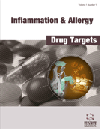- Home
- A-Z Publications
- Inflammation & Allergy-Drug Targets (Discontinued)
- Previous Issues
- Volume 14, Issue 2, 2015
Inflammation & Allergy-Drug Targets (Discontinued) - Volume 14, Issue 2, 2015
Volume 14, Issue 2, 2015
-
-
A Systematic Review of the Molecular Mechanisms of Uranium -Induced Reproductive Toxicity
More LessUranium is the heaviest metal known as nuclear fuel, and employed in the production of glass tinting compounds, ceramic glazes, gyroscope wheels, chemical catalysts and X-ray tube targets. Inhalation and ingestion are two of the most usual ways of exposure. Uranium may be released into drinking water through the mining leading to contamination. Uranium is able to damage the DNA by generation of free radicals and Read More
-
-
-
Inducible Nitric Oxide Synthase Expression in Liver Injury: Liver Protective Effects on Primary Rat Hepatocytes
More LessAuthors: Masaki Kaibori, Tadayoshi Okumura, Kenji Sato, Mikio Nishizawa and Masanori KonBackground/Aims: Following injury to the liver, liver cells, including Kupffer cells and hepatocytes express inducible nitric oxide synthase (iNOS), followed by the production of excess levels of nitric oxide (NO). NO produced by iNOS has been found to contribute to liver injury. Treatment of primary cultures of rat hepatocytes with the proinflammatory cytokine interleukin (IL)-1β stimulated iNOS expression and NO production Read More
-
-
-
Microbiome Regulation of Autoimmune, Gut and Liver Associated Diseases
More LessAuthors: Bhagirath Singh, Nan Qin and Gregor ReidExtensive analysis of the complexity and diversity of microbiota using metagenomics in the gut and other body sites has provided evidence that dysbiosis occurs in many disease states. With the application of next generation sequencing technology this research is starting to uncover the impact of microbiota on metabolic, physiological and immunological pathways and elucidate the cellular and molecular mechanisms inv Read More
-
-
-
Vaccination and Induction of Autoimmune Diseases
More LessAuthors: æ#137;ric Toussirot and Matthieu BereauVaccines have been suspected of playing a role in inducing autoimmune disease (AID) for a long time. However, apart from certain specific vaccine strains and complications (such as the swine flu vaccine and Guillain- Barré syndrome in 1976, thrombocytopenia and the Measles-Mumps-Rubella vaccine), this role has not been established. In spite of this, many isolated cases or series of cases of arthritis, vasculitis, and central or p Read More
-
-
-
LPS Up-Regulates Cystathionine γ -Lyase Gene Expression in Primary Human Macrophages via NF-ΚB/ERK Pathway
More LessAuthors: Alireza Badiei, Steven Gieseg, Sian Davies, Mohd Izani Othman and Madhav BhatiaHydrogen sulfide (H2S) is an endogenous inflammatory mediator produced by the activity of cystathionine γ–lyase (CSE) in mammals. Macrophages are a key element of the immune system and play a crucial role in inflammation. To determine the role of H2S and macrophages in inflammation, we investigated the expression of CSE in human primary macrophages. Our results show that H2S is produced by the activity of CSE in t Read More
-
-
-
GABAergic Agonists Modulate the Glutamate Release from Frontal Cortex Synaptosomes of Rats with Experimental Autoimmune Encephalomyelitis
More LessAuthors: Nicolás Fernández Hurst, Natalí L. Chanaday and German A. RothExperimental autoimmune encephalomyelitis (EAE) is an inflammatory demyelinating disease that mimics many of the clinical and pathological features of multiple sclerosis. We have previously described a significant diminution in the GABAergic regulation of glutamate release from synaptosomes of EAE rats isolated during the acute stage of the disease. In order to explore the possible metabolic pathways responsibl Read More
-
-
-
Imaging Patterns of Cardiovascular Involvement in Mixed Connective Tissue Disease Evaluated by Cardiovascular Magnetic Resonance
More LessBackground: To clarify the imaging patterns of cardiovascular lesions in patients with mixed connective tissue disease (MCTD) and cardiovascular symptoms with or/ without abnormal routine non-invasive evaluation. Patients-Methods: Twenty-two MCTD patients (19F/3M), aged 38±4 yrs with cardiovascular symptoms were evaluated using a 1.5 T scanner. Of them, 8/22 had systemic lupus erythematosus (SLE), 5/22 rheumatoi Read More
-
-
-
Anti-Inflammatory Role of Thyroid Hormones on Rat Air Pouch Model of Inflammation
More LessBackground: Many studies showed anti-inflammatory potential of thyroid hormones, but no direct report available showing influence of thyroid hormones on inflammation state. Therefore, in present study anti-inflammatory and antioxidative role of thyroid hormones being evaluated on rat air pouch model of inflammation. Methods: Reference doses of both the thyroid hormones triiodothyronine (T3) and thyroxine (T4) were Read More
-
-
-
Anti-Inflammatory and Antimicrobial Properties of Flavonoids from Heliotropium subulatum Exudate
More LessAuthors: Bharat Singh and Ram A. SharmaHeliotropium subulatum is an erect or procumbent perennial herb; leaves contain foliar trichomes and its resinous exudate is used in traditional medicine. The anti-inflammatory activity of dichloromethane fraction and isolated flavonoids was evaluated by using carrageenan and CFA-induced paw oedema models. Similarly, the disc diffusion and microdilution methods were used for the assessment of antimicrobial activity. Five Read More
-
-
-
6-Mercaptopurine for Azathioprine Intolerant Inflammatory Bowel Disease: Literature Search and Reappraisal of Own Data
More LessAuthors: Giovanni Clemente Actis, Rinaldo Pellicano and Floriano RosinaThiopurines have been shown to effectively maintain remission of both Crohn’s disease (CD) and ulcerative colitis (UC), and to behave as disease modifiers if used for >12 months in UC. Gastric intolerance manifesting as nausea constitutes a demanding drawback of thiopurines, at times forcing treatment discontinuance. A few studies have now indicated that some patients might tolerate mercaptopurine (6-MP) for azathi Read More
-
Most Read This Month
Article
content/journals/iadt
Journal
10
5
false
en


